
Konrad Zuse was a German civil engineer, pioneering computer scientist, inventor and businessman. His greatest achievement was the world's first programmable computer; the functional program-controlled Turing-complete Z3 became operational in May 1941. Thanks to this machine and its predecessors, Zuse has often been regarded as the inventor of the modern computer.
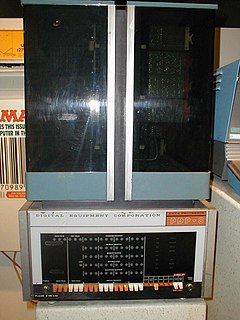
A minicomputer, or colloquially mini, is a class of smaller computers that was developed in the mid-1960s and sold for much less than mainframe and mid-size computers from IBM and its direct competitors. In a 1970 survey, The New York Times suggested a consensus definition of a minicomputer as a machine costing less than US$25,000, with an input-output device such as a teleprinter and at least four thousand words of memory, that is capable of running programs in a higher level language, such as Fortran or BASIC.

The PDP-11 is a series of 16-bit minicomputers sold by Digital Equipment Corporation (DEC) from 1970 into the 1990s, one of a set of products in the Programmed Data Processor (PDP) series. In total, around 600,000 PDP-11s of all models were sold, making it one of DEC's most successful product lines. The PDP-11 is considered by some experts to be the most popular minicomputer.

VAX is a CISC instruction set architecture (ISA) and line of superminicomputers and workstations developed by the Digital Equipment Corporation (DEC) in the mid-1970s. The VAX-11/780, introduced October 25, 1977, was the first of a range of popular and influential computers implementing the VAX ISA. Over 100 models were introduced over the lifetime of the design, with the last members arriving in the early 1990s. The VAX was succeeded by the DEC Alpha, which included several features from VAX machines to make porting from the VAX easier.

The Z3 was a German electromechanical computer designed by Konrad Zuse in 1935, and completed in 1941. It was the world's first working programmable, fully automatic digital computer. The Z3 was built with 2,600 relays, implementing a 22-bit word length that operated at a clock frequency of about 5–10 Hz. Program code was stored on punched film. Initial values were entered manually.

VEB Kombinat Robotron was the biggest East German electronics manufacturer. It was based in Dresden and employed 68,000 people (1989). It produced personal computers, SM EVM minicomputers, the ESER mainframe computers, several computer peripherals as well as home computers, radios, television sets and other items including a kleingebäckpresse.
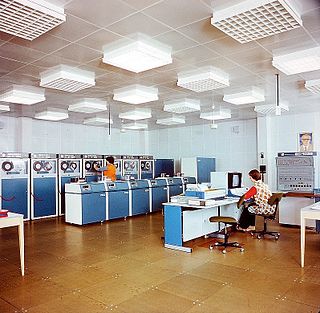
ESER is an abbreviation for Einheitliches System Elektronischer Rechenmaschinen, a term used in the GDR for ES EVM computers produced according to a treaty between the members of Comecon signed on December 23, 1968 covering the development of a standardized computing system.
The history of computing hardware in the Soviet Bloc is somewhat different from that of the Western world. As a result of the CoCom embargo, computers could not be imported on a large scale from Western Bloc.
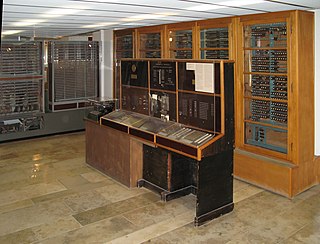
The Z4 was arguably the world's first commercial digital computer. It was designed by German engineer and early computer scientist Konrad Zuse and built from 1942 to 1945 by the company he founded, Zuse Apparatebau. The Z4 was Zuse's final target for the Z3 design. Like the earlier Z2, it comprised a combination of mechanical memory and electromechanical logic, so was not a true electronic computer.
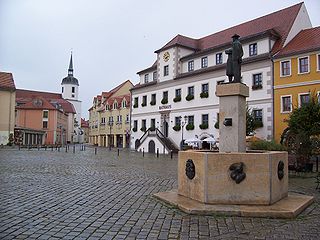
Hoyerswerda is a major district town in the district of Bautzen in the German state of Saxony. It is located in the Sorbian settlement area of Upper Lusatia, a region where some people speak the Sorbian language in addition to German.

The Z1 was a motor-driven mechanical computer designed by Konrad Zuse from 1936 to 1937, which he built in his parents' home from 1936 to 1938. It was a binary electrically driven mechanical calculator with limited programmability, reading instructions from punched celluloid film.
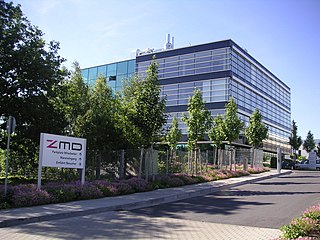
Zentrum Mikroelektronik Dresden (ZMD) was regarded as the heart of East Germany's microelectronics research in the 1980s as well as its most advanced integrated circuit manufacturer. Together with TU Dresden and VEB Spurenmetalle Freiberg, ZMD formed the foundation for Silicon Saxony, a cluster of microelectronics companies that came to include new fabs by Siemens and AMD.

The U880 is an 8-bit microprocessor that was manufactured by VEB Mikroelektronik "Karl Marx" Erfurt in the German Democratic Republic. Production of the U880 started in 1980 at VEB Funkwerk Erfurt. The U880 is an unlicensed clone of the Zilog Z80 microprocessor. It is not, however, a direct copy of the Zilog's Z80. Differences include not setting the CY flag for the OUTI command.

Werner Hartmann was a German physicist who introduced microelectronics into East Germany. He studied physics at the Technische Hochschule Berlin and worked at Siemens before joining Fernseh GmbH. At the end of World War II, he and his research staff were flown to the Soviet Union to work on their atomic bomb project; he was assigned to Institute G. In 1955, he arrived in the German Democratic Republic (GDR); in the same year, he founded and became the director of the VEB Vakutronik Dresden, later VEB RFT Meßelektronik Dresden. In 1956, he completed his Habilitation at the Technische Hochschule Dresden and also became a professor for Kernphysikalische Elektronik there. In 1961, he founded the Arbeitsstelle für Molekularelektronik Dresden (AME). He was awarded the National Prize of GDR in 1958. In 1974, he was removed from his positions, significantly demoted, and sent to work as a staff scientist at the VEB Spurenmetalle Freiberg. Hartmann had been the object of security investigations by the Stasi for some time; while he was investigated at length and repeatedly interrogated, the alleged charges were politically motivated and no trial ever took place. The Werner-Hartmann-Preis für Chipdesign is an industrial award given in Hartmann's honor for achievement in the field of semiconductors.

The MRB Z1013 was an East German Single-board computer produced by VEB Robotron Riesa which was primarily intended for private use and educational institutions. It was powered by a U880 processor and sold together with a membrane keyboard. Initially, the kit was equipped with 16-KByte DRAM, which was later replaced by a 64-KByte version.
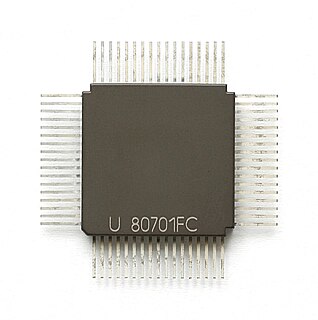
The U80701 was a 32-bit microprocessor developed from 1986-1990 in the German Democratic Republic. It was manufactured by VEB Mikroelektronik "Karl Marx" Erfurt (MME) in NMOS technology and encased in a ceramic quad flat package.

The Robotron KC 87, fully known as the Kleincomputer robotron KC 87, was an 8-bit home computer released in 1987 and produced in East Germany by the VEB Robotron-Meßelektronik "Otto Schön" Dresden, part of the Kombinat Robotron. The first model in the series, the Robotron Z 9001, was introduced in 1984 and renamed Robotron KC 85/1 in 1985. Despite similar names, the Robotron home computers were not directly related to the KC 85 series produced by the VEB Mikroelektronik "Wilhelm Pieck" Mühlhausen.
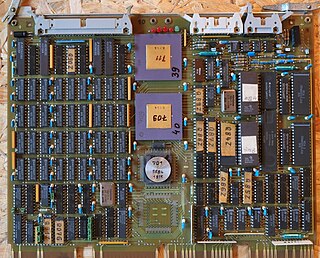
The K 1820, full name RVS K 1820, cipher in the SM EVM of the former COMECON countries SM 1720, was a workstation developed in East Germany. VEB Robotron Elektronik Dresden began development of the K 1820 in 1986 and it went into serial production in 1990.

VEB Kombinat Mikroelektronik Erfurt was an important manufacturer of active electronic components in East Germany. It should not be confused with the more well-known VEB Kombinat Robotron Dresden which used integrated circuits from Kombinat Mikroelektronik in its computers. The trademark RFT was used for components from Kombinat Mikroelektronik, as well as for most electronic products from East Germany.
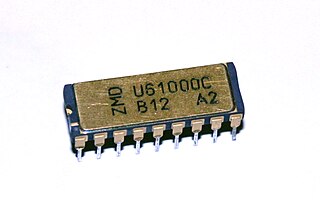
East Germany was one of the leading computer producers in the Eastern Bloc as purchases of higher technologies from the West were under various embargoes. A program of illegal purchases, copying and reverse engineering of Western examples was established, after which GDR sold these computers to COMECON countries. Under the rule of Erich Honecker electronics, microelectronics and data processing industries grew at average 11.4% in the 1970s and 12.9% during the 1980s.



















